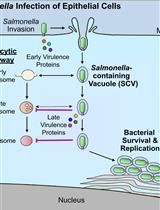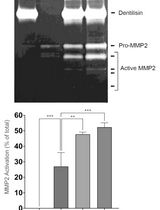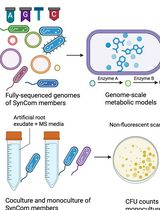- EN - English
- CN - 中文
Assessment of Caenorhabditis elegans Competitive Fitness in the Presence of a Bacterial Parasite
寄生菌存在情况下秀丽隐杆线虫的竞争适应性测定
发布: 2018年08月20日第8卷第16期 DOI: 10.21769/BioProtoc.2971 浏览次数: 5897
评审: Juan Facundo Rodriguez AyalaDURAI SELLEGOUNDERAnonymous reviewer(s)

相关实验方案

细菌病原体介导的宿主向溶酶体运输的抑制:基于荧光显微镜的DQ-Red BSA分析
Mădălina Mocăniță [...] Vanessa M. D'Costa
2024年03月05日 2679 阅读

通过制备连续聚丙烯酰胺凝胶电泳和凝胶酶谱分析法纯化来自梭状龋齿螺旋体的天然Dentilisin复合物及其功能分析
Pachiyappan Kamarajan [...] Yvonne L. Kapila
2024年04月05日 1862 阅读
Abstract
Accurate measurements of an organism’s fitness are crucial for measuring evolutionary change. Methods of fitness measurement are most accurate when incorporating an individual’s survival and fecundity, as well as accounting for any ecological interactions or environmental effects experienced by the organism. Here, we describe a protocol for measuring the relative mean fitness of Caenorhabditis elegans populations, or strains, through an assay that accounts for individual survival, fecundity, and intraspecific competitive ability in the presence of a bacterial parasite. In this competitive fitness assay nematodes from a focal population or strain are mixed with a GFP-marked tester strain in equal proportions, the mixture of nematodes are then exposed to a parasite, and the relative competitive fitness of the focal strain is determined by measuring the change in the ratio of focal nematodes to GFP-marked nematodes after one generation. Specifically, this protocol can be implemented to measure changes in nematode host fitness after experimental evolution by determining the relative competitive fitness of evolved versus ancestral nematode populations.
Keywords: Fitness assay (适应性测定)Background
Accurate measurements of fitness and changes in fitness over time are critical for determining a population’s response to natural selection. Nonetheless, fitness is notoriously difficult to measure because it incorporates an individual’s survival, fecundity, reproductive timing, and must account for ecological and environmental effects on individuals. Although no protocol for measuring fitness is optimal under all possible conditions, measures of fitness that account for survival and fecundity, while holding ecological and environmental effects constant, are likely to provide reliable overall estimates of fitness for a given scenario. Here we describe a protocol for measuring the relative fitness differences between C. elegans populations or strains and for determining the change in relative fitness over evolutionary time in the presence of a bacterial parasite. We utilized the gram-negative bacterium, Serratia marcescens, as a virulent parasite when consumed by C. elegans. Especially, S. marcescens strain SM2170 is capable of killing C. elegans hosts within 24 to 48 h of ingestion (Penley et al., 2017). This procedure makes use of Competitive Fitness Assays (CFAs) (Lenski et al., 1991; Wiser and Lenski, 2015), utilizing intraspecific competition to compare the relative fitness between different nematode populations or strains (Morran et al., 2009). Measurements of relative fitness, as determined via the CFA, incorporate survival and reproduction with intraspecific competition in a controlled environment to provide a comprehensive measure of fitness (Penley et al., 2017).
Relative fitness in the presence of the bacterial parasite is determined by competing a focal strain with an isogenic GFP-labeled tester strain over the course of one generation and measuring the reproductive success of the focal strain against the tester strain (Morran et al., 2009). Thus, this CFA accounts for survival against the parasite and host reproduction over the course of the nematode’s lifecycle. One single tester strain is used to measure the relative fitness of each focal nematode population or strain to facilitate comparisons of relative fitness between populations or strains. Importantly, the tester is marked with pharyngeal GFP to allow easy visualization of tester strain offspring versus focal population or strain offspring after one generation of competition. CFAs are initialized with a 50:50 mix of focal and tester strain individuals, and therefore, any deviation from 50:50 mix in the offspring indicates unequal competitive fitness between the focal and tester strains. An increase in the proportion of focal nematodes in the offspring indicates greater competitive fitness relative to the tester, while a decrease indicates reduced competitive fitness relative to the tester. The proportion of focal hosts in the offspring can be compared across multiple populations to measure the relative competitive fitness between focal strains or populations of interest. Importantly, competitive fitness measures are most effective when competing approximately equal numbers of individuals between two populations or strains with minor to moderate differences in competitive fitness. Uneven or variable starting ratios of strains or populations can confound measurements of relative fitness, while major differences in fitness between competing strains or populations are often difficult to accurately quantify (Wiser and Lenski, 2015).
This protocol is particularly useful for measuring evolutionary change after experimental evolution of C. elegans hosts in the presence of a bacterial parasite. First, the relative fitness of experimental host populations can be directly compared with the relative fitness of the ancestral population. Ancestral C. elegans populations can be stored at -80 °C during experimental evolution and then revived for CFAs to assess changes in the experimental population fitness over time (Gray and Cutter, 2014; Teotonio et al., 2017). Second, during experimental evolution, hosts may adapt to parasite exposure through altered life histories and/or increased levels of host defense. Therefore, measuring only survival in the presence of the parasite may not fully account for changes in host fitness. This CFA can account for changes in both life history and resistance that alter reproductive output in the presence of the parasite. Importantly, this procedure was originally developed to measure the change in C. elegans’ competitive fitness after multiple generations of evolution in presence of the bacterial parasite, Serratia marcescens (Morran et al., 2009; Morran et al., 2014; Parrish et al., 2016; Penley et al., 2017). Nonetheless, this protocol can be adapted to measure the relative competitive fitness of any two or more C. elegans populations or strains in the presence of any relevant bacterial parasite. Further, it can be used to measure the change in relative competitive fitness over the course of experimental evolution for any C. elegans populations evolved in the presence of a bacterial parasite.
Materials and Reagents
- 1.5 ml micro-centrifuge tube (MIDSCI, catalog number: MID15C )
- 1,000 μl pipette tips (MIDSCI, catalog number: AVR4 )
- 200 μl pipette tips (MIDSCI, catalog number: AVR1 )
- 1,000 μl wide bore pipette tips (Genesee Scientific, catalog number: 22-426 )
- 200 μl wide bore pipette tips (Genesee Scientific, catalog number: 22-423 )
- Microscope slides (Fisher Scientific, catalog number: 12-550-19 )
- Semimicro spatula (Fisher Scientific, catalog number: 14-374 )
- Disposable inoculating loops, 10 μl (VWR, catalog number: 12000-810 )
- 100 x 15 mm Petri dishes (Tritech Research, catalog number: T3301 )
- 0.22 μm sterile syringe filter (Spectrum Chemical Manufacturing, catalog number: 882-66597 )
- Disposable plastic syringe (Thermo Fisher Scientific, catalog number: S7510-10 )
- Serratia marcescens strain SM2170, BSL2 (Sue Katz, Rogers State University)
- Escherichia coli strain OP50, BSL1 (Caenorhabditis Genetics Center)
- GFP-labeled C. elegans (strain JK2735) (Caenorhabditis Genetics Center)
- Nematode Growth Media Lite powder (United States Biological, catalog number: N1005 )
- LB granules (Fisher Scientific, catalog number: BP9723-500 )
- Potassium Phosphate Monobasic (KH2PO4) (Fisher Scientific, catalog number: P288-100 )
- Sodium Chloride (NaCl) (Fisher Scientific, catalog number: S671-500 )
- Sodium Phosphate Dibasic Anhydrous (Na2HPO4) (Fisher Scientific, catalog number: S374-500 )
- Magnesium Sulfate Anhydrous (MgSO4) (Fisher Scientific, catalog number: M65-500 )
- Ampicillin Sodium Salt (Dot Scientific, catalog number: DSA40040-25 )
- Household bleach
- LB Broth (see Recipes)
- NGM Lite plates (see Recipes)
- Escherichia coli (OP50)-seeded NGM Lite plates (see Recipes)
- M9 Buffer (see Recipes)
- 1 M MgSO4 Solution (see Recipes)
- Ampicillin 200 mg/ml (see Recipes)
Equipment
- Hand tally counters (United Scientific Supplies, catalog number: HTCP01 )
- 2 L flask (Corning, PYREX®, catalog number: 5320-2L )
- P1000 μl pipetman (Eppendorf, model: Research® plus, catalog number: 3121000120 )
- P100 μl pipetman (Eppendorf, model: Research® plus, catalog number: 3121000074 )
- -80 °C freezer (Eppendorf, New BrunswickTM, model: Innova® U725 )
- Tabletop centrifuge for 1.5 ml micro-centrifuge tubes (Eppendorf, model: 5424 )
- 20 °C controlled environment chamber (Percival Scientific, model: I36NLC8 )
- 28 °C shaker incubator (Eppendorf, New BrunswickTM, model: Innova® 42R , catalog number: M1335-0010)
- Stereomicroscope (Olympus, model: SZX16 )
- LED transmitted light illumination base (Olympus, model: SZX2-ILLT )
- GFP filter for stereomicroscope (Olympus, model: SZX2-FGFP )
- Stereomicroscope objective 7x-115x (Olympus, model: SDFPLAPO1XPF )
- Fluorescence illumination lamp (Excelitas Technologies, model: X-Cite® 120Q )
- X-Cite® Liquid Light Guide (Bulbtronics, Excelitas Technologies, model: 805-00038 )
- Autoclave (STERIS, model: SG-120 )
- Chemical fume hood (Kewaunee Scientific, model: H05 )
Software
- JMP Pro 12.0.1 (SAS Institute Inc., Cary, NC)
Procedure
文章信息
版权信息
© 2018 The Authors; exclusive licensee Bio-protocol LLC.
如何引用
Penley, M. J. and Morran, L. (2018). Assessment of Caenorhabditis elegans Competitive Fitness in the Presence of a Bacterial Parasite. Bio-protocol 8(16): e2971. DOI: 10.21769/BioProtoc.2971.
分类
微生物学 > 微生物-宿主相互作用 > 细菌
您对这篇实验方法有问题吗?
在此处发布您的问题,我们将邀请本文作者来回答。同时,我们会将您的问题发布到Bio-protocol Exchange,以便寻求社区成员的帮助。
提问指南
+ 问题描述
写下详细的问题描述,包括所有有助于他人回答您问题的信息(例如实验过程、条件和相关图像等)。
Share
Bluesky
X
Copy link










